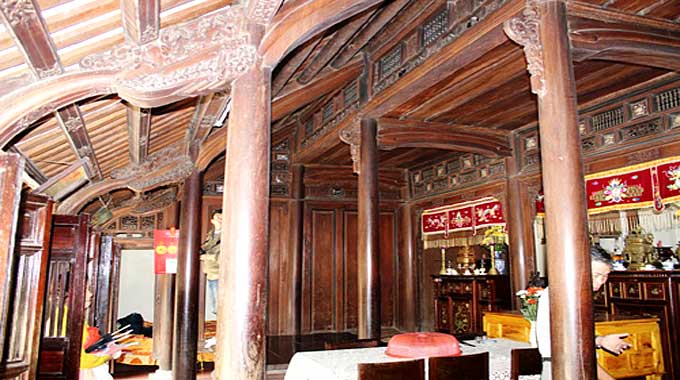Hoi Ky ancient village in Hai Chanh commune, Hai Lang district, Quang Tri province is located by the O Lau river. The village is more than 500 years old.

Visitors to the village are amazed at the numerous ancient wooden houses known as Nha Ruong, religious establishments, and the peaceful lives of the local people.
Along road to Hoi Ky village are temples, pagodas and clan worship houses which boast unique architectural styles. But visitors are most amazed at the centuries-old wooden houses nestled in large gardens along O Lau River.
These houses, which belong to the Duong family clan are comprised of 5 or 7 rooms and wing rooms and are made of thick solid wood. Their columns and doors are engraved with dragons, unicorns, phoenixes and other delicate patterns.
In each house, there are lacquered boards with parallel sentences teaching children to do good. Doors between rooms are beautifully decorated. The room in the middle is used to worship the ancestors while its two neighboring rooms serve living and bed rooms.
Of the other two wing rooms, the one on the west is for boys and the one on the east is for girls. There’s also an entresol in the house that contains rice and other home objects.
Duong Van Cho is a local in Hoi Ky village. He said, “Among the 20 ancient houses in the village, 6 have 3 main rooms and 2 wing rooms. They are about 100 years old. Local people have restored their houses and all want to maintain their identity”.
Depending on the size of the house, each roof has between 10,000 and 20,000 brick tiles made of clay. The tiles are rectangular, thin, flat and can produce a bell sound when they are knocked. This way of tiling makes the house cool in summer and warm in winter.
Walls of the house are made of lime and wood hammered bricks. Every house is surrounded by trimmed green tree fences.
Doctor Le Vinh An is of the Advisory Committee for Hue Ancient Capital Preservation. He noted, “Hoi Ky ancient village still retains its values. The village was founded in the 15th century but its houses are between 100 and 150 years old. The landscape in the village is beautiful with a river zigzagging around the village, small lanes, wharves, and a communal yard. These are typical characteristics of rural Viet Nam”.
Mr. Duong Van Manh’s house which is comprised of 3 main rooms and 2 wing rooms and a roof with 10,000 tiles is the most typical. Named “Happiness convergence”, the house is situated in the middle of a large garden.
Built in 1889, the house is sustained with 48 jackfruit wooden columns. Built in 1931, Ms Duong Thi Huong’s house has one main room and 2 wing rooms and covers about 60 square meters. Inside the house, there’s a lacquered board saying “4 generations living in the same house”.
According to traditional beliefs, a house with 4 generations living together is a happy house. Most of the houses in Hoi Ky hang a lacquered board with the word “Peace” on it.
Nguyen Thanh Nam is from Quang Nam province. He shared, “The architecture of the houses is outstanding. Their structures are also sustainable because they all have solid columns. The roof of the house is low helping to protect the house from strong winds”.
The locals in Hoi Ky are proud of their houses which stand firm and retain their traditional values despite of war and climate devastation. These houses have great historical, cultural and architectural values, according to Kitani Kenta, an expert from the UNESCO’s World Heritage Institute at Japan’s Waseda University.
Kitani Kenta says the ancient wooden houses of Hoi Ky are wonderful, sophisticated and skillfully built. These outstanding features need to be promoted’.